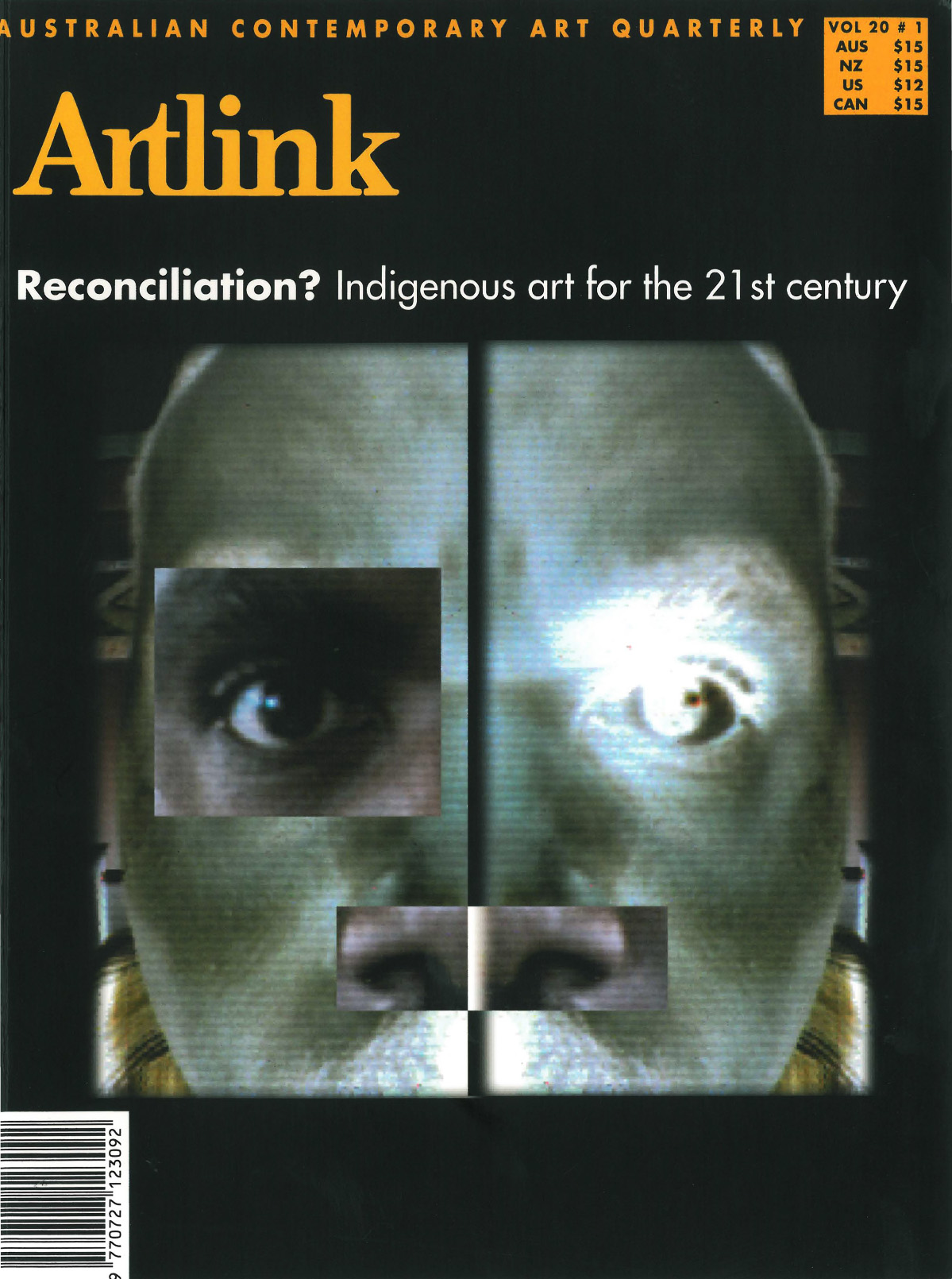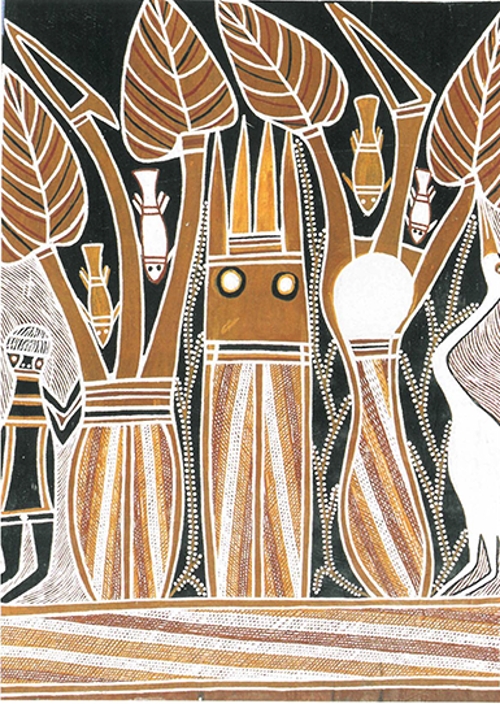Search
You searched for contributors, issues and articles tagged with Maps ...
Contributors
Basil Hall
Brenda L Croft
Bronwyn Bancroft
Chris Lee
Christine Nicholls
Cynthia Coyne
Darlene Johnson
Darryl Pfitzner Millika
Doreen Mellor
Felicity Wright
Franchesca Cubillo
Gary Lee
Gaye Sculthorpe
Janet Maughan
Jenny Green
John Dallwitz
John Kean
Jon Altman
Judith Ryan
Ken Watson
Kim Akerman
Liesl Rockchild
Lotte Waters
Marcia Langton
Margie West
Margo Neale
Maurice O'Riordan
Michael O'Ferrall
Patricia Vinnicombe
Paul Taìon
Philip Morrissey
Richard (Dick) Kimber
Robyn Healy
Ruth Megaw
Sharon Phillips
Sue Angel
Susan Congreve
Susan Hartley
Sylvia Kleinert
Tamara Winikoff
Tjalaminu Mia
Vincent Megaw
Vivien Johnson
Issues

Reconciliation: Indigenous art for the 21st Century
Issue 20:1 | March 2000
Articles

Lin Onus
Lin Onus had a remarkable career, from motor mechanic and political activist to maker of marvellous, witty and original paintings and sculptures. He was also widely loved and respected for his compassion and willingness to lead the cause of Aboriginal advancement.

Polemic: From the 21st Century and Through the Telescope
Polemic: There has been a paradigm shift in Australia with the development of Aboriginal art, which may be as consequential as that of the Impressionists. Over the last 30 years Aboriginal artists have been making their voices heard and now make up at least 25% of the country's working visual artists though they are only 1.7% of the population. Their art will go down in history as providing new perspectives with which to view the world

New insight into old North Australian Rock-Art
The rich rock art of Australia, especially of Arnhem Land and the Kimberly continues to be the subject of research, as well as fierce debate about their meaning and age, with obvious implications for Aboriginal cultural history. Three signficant styles are identified : the 'Bradshaws', (named after explorer Joseph Bradshaw who discovered them in the 1800s) the 'Dynamic' and the 'Wanjina' paintings. Most of the more than 100,000 ancient sites are not effectively protected but are of great importance to living Aboriginal people.

Homeland: Sacred Visions and the Settler State
In spite of supporting a vast artworld of curators, critics and collectors, the 'otherness' of Aboriginal art in the Western canon persists, fuelled by white settler reluctance to acknowledge history. The valorisation of the life and work of Emily Kame Kngwarray is one of the great imponderables of our time. Her extreme age, traditional origins, style of painting and prodigious output were the causes. Most significantly she demonstrated the possibility of human intimacy with landscapes.

Emily Kame Kngwarray
A tribute to Emily Kame Kngwarray the celebrated painter from Sandover near the central desert community of Utopia, who died in 1996 after a meteoric career during which she produced 3,000 works in 8 years. Although her concern was to paint and thus protect her country (her main subject was the pencil yam after the seeds and flowers of which - kam - she was named) she was acclaimed by some as a major abstract painter of the 20th century. She won a major creative fellowship and was posthumously shown at the Venice Biennale.

Queenie McKenzie
A tribute to the Western Australian artist Queenie McKenzie who died in 1998. She lived her whole life in the Texas Downs area and before taking up painting in old age she worked on the cattle station there and was a stalwart supporter of 'women's law business' and language. She was a confident and prolific painter mostly of her country but sometimes of social topics. When her work was recognised by the art market she shared her material success generously with her adopted family.

Rover Thomas
A tribute to the Western Australian artist Rover Thomas who died in 1998 aged around 72. After a full life spent as a stockman and an important leader of ceremonial life through the Kurirr-Kurirr dance cycle in the Warmun community, in 1982 he began establishing a new mode of painting based on Kimberly rock art. His bold and original painting depicts the land and the massacres that took place there up to the 1950s. The National Gallery of Australia accorded him a retrospective exhibition Roads Cross in 1994.

M.N. Tjapaltjarri
A tribute to Mick Namarari Tjapaltjarri born c.1926 in Pintupi country and who died in 1998. He lived in Papunya and was encouraged by Geoff Bardon to start painting and was a member of the Papunya Tula Artists Company. By 1991 when he won the National Aboriginal Art Award his works were being acquired by national collections and many other collectors.

Y.Y. Gibson Tjungurrayi
A tribute to the Pintupi painter Yala Yala Gibbs Tjungurrayi born c.1928 in the region of Kintore and died in 1998. He was a strongly traditional man and after migrating to Papunya he was encouraged by Geoff Bardon to take up painting. His works, mainly the Tingari stories to do with the ceremonial stories of ancestral men, were acquired by collections in Australia and internationally.

George Milpurrurru
Tributes to two painters from Ramingining in Arnhem Land, George Milpurrurru and David Malangi who helped to place this region on the map. Paintings were included in the 1979 Sydney Biennale. The iconography, style of painting and the public response to their work and interaction with the wider art world is discussed. Both of these major artists died during the 1990s after careers of around four decades.

The 'Aboriginal Art Scandals' Scandal
A chronicle of a spate of so-called 'Aboriginal art scandals' which happened in the late 1990s, some of which involved white artists passing off work as Aboriginal. The custom amongst indigenous artists of family members working with an artist on paintings creates problems for the western art market and leads to claims of fraud. The media is often guilty of distorting and sensationalising events. The newly launched Label of Authenticity enters the scene.

Black Glory: Erotica Old and New
The exhibition 'Love Magic' explored Aboriginal male erotica and reveals a little-known dimension in traditional spirituality which has been echoed by contemporary artists. Images of phalluses, couples embracing and testicles going walkabout refer to legends and stories of the Old People. This very large exhibition was a life-affirming spectacle with humour and poignancy as well as some powerful eroticism.

Looking at the Stolen Generation
The government policy of separating Indigenous children from their parents was still in force until the 1970s in some states. Indigenous artists who have recently begun depicting these events include Julie Dowling, Gordon Syron, John Packham, Rea and Brenda Croft. Their work has been part of the uncovering of the hidden history of these children of which many non-indigenous Australians were quite ignorant until the mid 1990s.

Good Brother Working with our Kids
Ron Gidgup was the first Aboriginal fashion designer in WA. Since getting the Aboriginal of the Year Award in 1997 he began to turn his skills towards helping Aboriginal youth in crisis. He runs workshops in textile and clothing design and brought many young people back from the brink of death from substance abuse. He has worked in urban and rural settings, with schools and other groups.

Charting Co-existence
Mapping Our Countries was an exhibition at the short-lived Djamu Gallery in Sydney, curated by artist Judy Watson and archaeologist Dr Paul Ta'on. They collected objects and works of art to illustrate how they relate to the idea of mapping land or sea. Mapping is done for a huge variety of reasons, for exploiting resources, for proving theories, for simply finding one's way.

Health and Art: Can art make people (feel) well?
Art can function in a wide range of ways beyond what is normally regarded as its arena. It can empower by raising confidence, providing income which can be used to improve diet and living conditions, it can be therapeutic, liberating and provide an emotional and intellectual outlet, while posters and TV ads can convey important messages about health issues. When a culture is strong the people are healthy.

Photography with Intent
Various indigenous artists began to use photography to express ideas about their social and political position in the 1980s; the 1988 Bicentennial celebrations were a strong catalyst. Formerly they were always on the other side of the lens, as anthropological subjects. The exception was Mervyn Bishop, employed as a press photographer in the 1960s, and pioneer in the medium and role model for younger artists including Fiona Foley, Ricky Maynard, Peter McKenzie.

Challenging boundaries: Indigenous Art in Three Dimensions
Recent Indigenous 3-D work is regarded as both art and craft. The materials range from shell and rushes to scrap steel, grass, ceramic, glass and bull kelp; the works may be vessels, installations, necklaces, small figures etc. The works often contain explicit references to cultural or historical truths eg the figures by WA artist Joyce Winsley which recall characters from her youth in the country, or Lola Greeno's water containers made in the traditional way from bull kelp .

Printmaking Gains Momentum
The first Aboriginal prints were linocuts made in jail by Kevin Gilbert. By the late 1970s Aboriginal printmaking in collaboration with print studios had begun. The Canberra School of Art, Port Jackson Press and now Northern Editions have been catalysts for the many enthusiasts at the Yirrkala, Papunya, Tiwi, Munupi, Oenpelli, Ernabella etc communities and workshops are run in remote centres at their request. Some like Lockhart River are now setting up their own facilities.

Political Theatre in Beyond the Pale
The Adelaide Biennial of Australian Artin 2000 was a survey of new indigenous art titled Beyond the Pale. This attempt to show the best of new work was staged as a series of rooms each with a different mood from baskets and shimmering paintings to rooms of confrontation where works invited viewers to be shocked by figures of authority seen in very unflattering mode.

Bush Toys
Bush Toys was an exhibition of toys made from scraps of metal and copper wire by the male members of the Eastern Arrente tribe of Central Australia in the late 1990s. These recall the era when Aboriginal people were the backbone of the pastoral industry, as stockmen and horse trainers. There are miniature horses and riders, windmills and stockyards, and wooden 'cars' for children to push along or ride in. The toys are a source of great pride for the men who make them.

Art in Warmun community
A new art centre at Warmun in the Kimberly of WA is a showcase for the talents of the artists of the area, some of whom used to work on big pastoral stations in this remote area. Celebrated founders of the centre were Rover Thomas and Queenie Mckenzie. There are tensions between their interests and those of white landowners in relation to access to 'country' being denied. Young people are unable to have a traditional education and are becoming westernised through videos.

New Ways With Clay: Tiwi Pottery
The Tiwi people on Melville and Bathurst Islands just north of Darwin have a 30-year tradition of pottery. They have absorbed a range of influences from the British Michael Cardew to visiting potters from Australia or via annual workshops with a Swiss potter Claude Presset. Some pots were collaboratively done - thrown by experienced potters and decorated by local artists. Slab and coil pieces drew on artists' experience in wood carving and painting.

Tandanya: One City and a Festival
3SPACE -C21st Indigenous Explorers was an exhibition by Darryl Pfitzner Millika, Mark Blackman and David Pearce for the 2000 Adelaide Festival. In common is their shared history as contemporary indigenous artists in Adelaide, the city which had the first indigenous art centre Tandanya, a powerful catalyst for many enterprises which without it would not have been so well presented or widely seen.

Boomalli: Fact or Fantasy: you decide!
Boomalli, founded in 1987, enters an unlikely future where anonymous benefactors help them to buy premises in an inner city suburb, to employ curators and become independent of funding bodies. Tax-free havens are set up for indigenous artists in NSW and Boomalli members exhibit regularly at MOMA in New York.

Judy Watson's etched zinc wall at Bunjilaka
Queensland artist Judy Watson spent three months in Melbourne on a commission for a zinc wall around 50 metres long for the Bunjilaka gallery at the new Museum Melbourne. Watson used motifs relating to Aboriginal material culture in the etched panels of this work.

Contemporary Voices: Australian Aboriginal Cultures Gallery in the SA Museum
The new Aboriginal Cultures Gallery at the SA Museum has set a new standard of excellence in interpretation of historical material. The use of film, video and computer terminals carrying extensive information from songs and interviews to historical documentation adds to the rich texture of the displays. Contemporary Voices is a set of filmed interviews conducted by museum staff in the six months before the opening of the new Gallery

Labelled - Buyer Be Aware
The introduction of a Label of Authenticity has some problems for contemporary urban Aboriginal artists who feel once again that they are being asked to confirm their status. Another issue is that any indigenous person can apply for the Label regardless of the integrity of their art practice. Is the Label too blunt an instrument to be useful to most artists?

The Indigenous Visual Arts Industry: Issues and Prospects for the Next Decade
The economics of indigenous art is analysed in detail in relation to production, collection and distribution, consumption, developments in the 1990s, prospects for the next decade, tourist art, protection of intellectual property, quality control, authenticity and leadership.

Fair Trade in Central Australia
Without regulation in a market there will always be carpetbaggers. Warlukurlangu Artists was set up by a group of artists to protect them from this. DESART, the peak body for Central Australian art producers, in 2000 has initiated a Central Australian Indigenous Art Label which aims to educate consumers and lead the way by example rather than police a market.

The House of Aboriginality
The House of Aboriginality is an evolving multimedia project about the merchandising of Indigenous imageries. A CD-rom sets out the story of the circulation of this in mainstream culture through the metaphor of a house entirely furnished with products bearing Aboriginal art designs.

Snapshot of a Culture
A conference about Indigenous arts and crafts was held in 1999 and was a useful sounding board for issues from the new Label of Authenticity and copyright, to the new Goods and Services Tax and art in cyberspace.

The Art and Craft Centre Story
Review of The Art and Craft Centre Story Volume I by Felicity Wright and Frances Morphy. This is an exhaustive survey of Indigenous art centres examining every aspect of their operations. The appalling conditions under which the staff of these centres work bely the extraordinary success of these centres. The authors recommend adoption of a policy of coordinated help with human resources.

Nomad to TV star in three years: Walala Tjapaltjarri meets the world
In late 1984 Walala Tjapaltjarri and other Pintupi tribespeople walked out of the Gibson desert in WA and met Europeans for the first time. Within a few years Walala adapted his traditional ground and body painting to painting on canvas and was filmed by Robert Hughes for his TV series Beyond the Fatal Shore.

Remote Area Computer Art: Multi-Media Talent Emerges in Yuendumu
Donovan Rice is a young Warlpiri man who has virtually taught himself to make computer art in the remote community of Yuendumu. He is making digital images and animations which relate to his own cultural situation against the backdrop of a chronically disfunctional society. He works under the aegis of Warlpiri Media, a community-run media resource centre and TV production house.

Indigenous.arts.online - Virtual Sales of Actual Art? Profit or Promotion
The obstacles to Indigenouse people selling their art on the internet are many and daunting for most. Some pioneer groups like Boomalli and Warlukurlangu Artists have web sites, but in the near future Indigenous art sales on line will be an accepted way of operating. Some web sites are listed.

Snapshots of Contemporary Sound, Movement and Words from Broome
Broome is a town in WA with a long history of many cultures living and working together. It is the home of a vibrant Indigenous music industry, its most famous sons being the Pigram brothers and Jimmy Chi, author of the musicals Bran Nue Day and Corrugation Road . Magabala Books is flourishing, and the Stompen' Ground Festival is gaining in strength and reputation.

David Malangi
Tributes to two painters from Ramingining in Arnhem Land, George Milpurrurru and David Malangi who helped to place this region on the map. Paintings were included in the 1979 Sydney Biennale. The iconography, style of painting and the public response to their work and interaction with the wider art world is discussed. Both of these major artists died during the 1990s after careers of around four decades.






